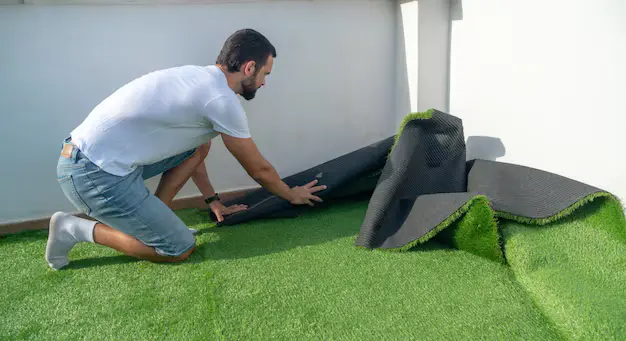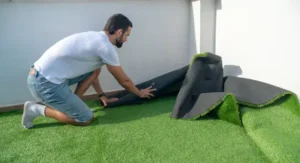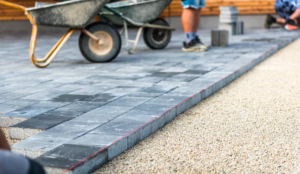Transforming your outdoor space with artificial grass installation is a fantastic way to create a low-maintenance, beautiful garden that you can enjoy all year round. Many people think installing it is complex, but with the right tools and some determination, it’s a task that can easily be completed over a weekend. Follow this step-by-step guide to ensure a clean and professional finish, and be proud of your new garden.
How To Install Artificial Grass
Follow these six simple steps to fit artificial grass and achieve a professional finish:
- Plan and clear the area
- Create an edge
- Lay the base
- Apply the weed membrane
- Lay the artificial grass and trim the edges
- Add finishing touches
Below, we’ll break each step down to ensure your installation is a success.
Plan & Clear the Area
Start by deciding which area you want to cover with artificial grass. Check for any obstacles underground, such as water pipes or electric cables, to ensure you won’t run into problems when digging.
Next, remove the existing turf or surface to a depth of about 5 cm (2 inches). Use a spade or, to make the job quicker, a turf cutter. Clear away any debris like stones or bricks that might get in the way, then lay a Type 1 aggregate base to provide a stable foundation.
Create an Edge
If your space doesn’t already have boundaries for the grass to rest against, you’ll need to install an edging system. You can use garden timber, metal edging, or products like VertEdge. Hammer them into the soil using a piece of wood to avoid damaging the edges, leaving about 3 cm exposed above the surface.
Lay the Base
Once your edges are in place, spread a layer of granite dust across the entire area. Aim for a depth of around 6 mm. Use a straight piece of wood to level the surface by dragging it over the dust evenly. If you’re levelling large imperfections, you may need to use hardcore first. For the best results, the dust should be compacted to create a durable and even layer.
Apply Weed Membrane
Now it’s time to lay down the weed membrane. This is crucial in preventing weeds from growing through your artificial grass while still allowing water to drain away. Secure it in place using galvanised nails around the edges, spaced roughly 75 cm apart. Trim off any excess membrane material to fit the space neatly.
If your project area requires joining separate sections of membrane, overlap the edges and stick them together with gaffer tape for a continuous barrier.
Lay the Artificial Grass & Trim Edges
Roll out the artificial grass across the prepared area. Make sure it’s laid flat and ensures the pile direction faces towards the house for the most appealing look. Avoid moving the weed membrane during this process.
With the grass in position, trim any excess material using a sharp Stanley knife. For a cleaner edge, change the blade regularly to prevent it from becoming dull. Finish securing the grass by attaching it to the edging with either nails or adhesive, depending on your chosen method.
Add Finishing Touches
To give your artificial grass a neat and natural appearance, brush kiln-dried sand into the pile. Spread around 6-8 kg of sand per square metre of grass using a lawn spreader or stiff brush. This step helps to weigh the grass down and keep the blades standing upright. Make sure to complete this task on a dry day for the best results. Finally, give the grass one last brush to fluff up the pile and ensure everything looks perfect.
Benefits of Artificial Grass
Artificial grass offers numerous features and advantages, making it a smart choice for homes, businesses, and public spaces alike. Here are some of the key benefits:
- Low Maintenance: No more mowing lawns or worrying about fertilisers and garden upkeep. Artificial turf saves time and effort with its low maintenance requirements.
- Beautiful Year-Round: Unlike real grass, artificial turf looks stunning all year, even after heavy rain or snow. You’ll never have to deal with brown patches or unsightly muddy spots again.
- Cost-Effective: Artificial grass helps cut costs in the long term by saving money on water bills, gardening tools, and maintenance services.
- Durability: Designed to endure foot traffic, adverse weather, and everyday use, artificial grass is both robust and reliable.
- Pet-Friendly: Soft yet sturdy, our pet-friendly artificial grass is simple to clean and resilient to pet mess, making it the ideal option for homeowners with dogs or other animals.
- Eco-Friendly: Reduce your water consumption and cut down on harmful chemicals like fertilisers and pesticides by switching to artificial grass, making it a more sustainable outdoor option.
Installation and Maintenance
Though installing and maintaining artificial grass might seem tricky at first, the process is actually quite simple. Here are our top tips for ensuring a smooth and successful experience:
- Preparation: Before installation, make sure the area is cleared of weeds, dirt, and debris. A strong foundation will help your artificial grass last longer and look better for years to come.
- Exact Placement: When laying out fake grass, ensure it’s secured properly with the correct fixings, such as adhesives or nails. This will leave you with a seamless finish and prevent movement over time.
- Basic Cleaning: Keeping your artificial grass looking fresh is straightforward! Simply use a soft brush to remove any dust, leaves, or debris.
- Repairs: Should any part of your turf become damaged, it can easily be fixed by replacing the affected section with new artificial grass.
What’s the Best Artificial Grass?
Navigating the wide variety of options while looking for the perfect artificial turf can feel overwhelming. We’ve picked out some of our top products to help make your decision easier:
- Budget-Friendly: Our 20mm artificial grass options are affordable, durable, and provide a realistic finish, making them ideal for a wide range of uses.
- All-Rounder: Looking for something versatile? The 30mm and 40mm range combine comfort with strength, perfect for busy family gardens.
- Premium Choice: When you want the very best, our premium 42mm and 43mm collections offer exceptional quality, plush textures, and long-lasting durability.
Why Choose Us Reliable Landscaper Cheshire
At Reliable Landscaper Cheshire, we understand that installing artificial grass can be time-consuming and physically demanding. That’s where we come in! Our team in Liverpool specialises in expertly crafting and transforming outdoor spaces with precision and care.
It’s time to create the garden you’ve always wanted! Whether you need advice, materials, or full installation services, we are here to help. Contact us today to bring your vision to life.
Get in touch
Don’t wait to transform your outdoor space. Reach out now for a free consultation and quote on your artificial grass project. Your new, low-maintenance, and beautiful lawn is just a step away. Get in touch with us today!
FAQs
Do You Put Anything Under Artificial Grass?
Yes, you should install a weed membrane and a compacted sub-base, such as gravel or crushed stone, under artificial grass. These layers ensure stability, prevent weed growth, and allow for proper drainage.
What Foundation Is Needed For Artificial Grass?
A solid foundation for artificial grass includes a compacted sub-base, like crushed aggregate or gravel, and a weed-proof membrane. Together, these layers provide stability, drainage, and protection against weed growth.
How Do You Prepare Ground For Artificial Grass?
Remove existing vegetation, debris, and rocks. Level and compact the soil. Install a weed membrane and lay down a sub-base, such as crushed stone or gravel. Compact the base and smooth it to create an even surface.
What Does Artificial Grass Sit On?
Artificial grass sits on a compacted sub-base of crushed aggregate or gravel, covered by a weed membrane. These layers provide stability, proper drainage, and protection against weed growth.
Is It Easy To Lay Artificial Grass Yourself?
Laying artificial grass yourself is moderately easy, especially for small areas. It requires preparation, tools, and some physical effort. Following a step-by-step guide can help, but professional installation may be better for large or complex projects.
Is Installing Artificial Grass Difficult?
Installing artificial grass involves steps like clearing the area, creating a sub-base, and fitting the turf. While not overly difficult, it can be labor-intensive. With proper tools and preparation, it’s manageable for a DIY installation.
Is It Cheaper To Do Artificial Grass Yourself?
Yes, installing artificial grass yourself is typically cheaper as you avoid labor costs. However, mistakes during installation may lead to additional expenses, so proper preparation and tools are essential.
What Should I Put Down Before Installing Artificial Grass?
Lay a weed-proof membrane and a compacted sub-base, such as crushed aggregate or gravel, before installing artificial grass. These layers provide stability, prevent weed growth, and ensure proper drainage.
What Is The Cheapest Way To Lay Artificial Grass?
The cheapest way involves DIY installation. Clear the ground, lay a weed barrier, and compact a basic sub-base like gravel. Although cost-effective, ensure quality materials to avoid long-term problems.
Can You Lay Artificial Grass Without Sand?
Yes, but it’s not ideal. Without sand, the grass may shift, blades won’t stand upright, and the surface may look less natural. Sand adds stability, weight, and longevity to your artificial grass.
Is Sand Necessary For Artificial Grass?
While not mandatory, sand is highly recommended. It helps stabilize the grass, keeps the blades upright, and enhances drainage. It also prevents wrinkling and extends the life of the artificial turf.



